Frequency, Intensity and Influences of Tropical Cyclones in the Northwest Pacific and China, 1977–2018
Abstract
:1. Introduction
2. Data and Methods
2.1. Data Sources
2.2. Research Methods
3. Results and Analysis
3.1. Characteristics of Tropical Cyclone Frequency in the Northwest Pacific
3.2. Intensity of Tropical Cyclones in the Northwest Pacific
3.2.1. Interannual Variation
3.2.2. Seasonal Changes
3.3. Characteristics of the Origin of Tropical Cyclones in the Northwest Pacific
3.4. Characteristics of Tropical Cyclones That Affected China
3.4.1. Frequency of Tropical Cyclones That Affected China
3.4.2. Intensity of Tropical Cyclones That Affected China
4. Discussion
4.1. Influencing Factors on Northwest Pacific Tropical Cyclones
4.1.1. Relationship between EIOSSTA, SSTG, El Niño and Tropical Cyclone Frequency
4.1.2. Relationship between SST, El Niño and Tropical Cyclone Intensity
4.2. Influence on Northwest Pacific Tropical Cyclones Based on Geographical Detector
4.2.1. Influence of SST Factors on the Frequency of Tropical Cyclones in the Northwest Pacific Ocean
- (1)
- The contributions of the single SST factors EIOSSTA, SSTG, and El Niño were all low in the thirteen sub-regions and much lower than those of the interaction factors (Figure 14a–c). Among the single factors, the highest contributions of EIOSSTA, SSTG, and El Niño were 0.33, 0.22, and 0.27. However, the contributions of each subdivision increased significantly after the interaction, among which the highest contributions of EIOSSTA and SSTG, EIOSSTA and El Niño, SSTG and El Niño were 0.73, 0.54, and 0.65, respectively (Figure 14d–f). Combined with Table 1, it can be found that the interaction type of the three SST factors was a two-factor enhancement, indicating that any combination of two SST factors has played a significant role in promoting the increase in the contribution of tropical cyclone frequency.
- (2)
- It was found that when two factors interact, the impact on TCGF in the coastal and eastern regions of Japan is significant. Especially, the contribution of EIOSSTA interacting with SSTG to TCGF in the two subdivisions around Japan reached 0.73 and 0.49, which was the highest among all subdivisions. Meanwhile, the contribution of EIOSSTA interacting with El Niño and SSTG interacting with El Niño to the TCGF in the subdivision around Japan also remained high. Combined with the study of Xu et al. [45], it can be argued that the area affected by tropical cyclones in the Sea of Japan accounts for a high percentage, and it was affected by 140 tropical cyclones from 1990 to 2017. Among them, the South China Sea region exhibited the most serious impact.
- (3)
- The results of the factor interaction in the South China Sea region are at a high level overall, indicating that TCGF in the South China Sea region is closely related to the three SST factors, especially the results of the EIOSSTA and El Niño interaction and the SSTG and El Niño interaction, which contribute 0.54 and 0.46 to the frequency of tropical cyclones, second only to the sea around Japan. By combining the tropical cyclone landfalls in China from 1977 to 2018, it is clear that Guangdong, Guangxi, Fujian, Hainan, and Taiwan provinces are the main regions of tropical cyclone landfalls, and all of these regions are close to the South China Sea.
4.2.2. Influence of SST Factors on the Intensity of Tropical Cyclones in the Northwest Pacific Ocean
- (1)
- The contribution of a single factor to the intensity of tropical cyclones in the thirteen sub-regions was much lower than that of the interaction factor (Figure 15a–c). Among the single factors, the highest contributions of EIOSSTA, SSTG, and El Niño were 0.30, 0.19, and 0.23, respectively. However, the contributions of each subdivision increased significantly and altered the interaction, among which the highest contributions of the EIOSSTA and SSTG, EIOSSTA and El Niño, and SSTG and El Niño interactions were 0.54, 0.57, and 0.73, respectively (Figure 15d–f). Combined with Table 1, it can be found that the interaction types of the three SST factors are also two-factor enhancements, indicating that any combination of two SST factors has played a significant role in promoting the contribution of tropical cyclone intensity. This result is also consistent with the effect of the interaction factor on tropical cyclone frequency in Section 4.2.1.
- (2)
- The overall contribution of EIOSSTA, SSTG, and El Niño interaction to tropical cyclone intensity in the coastal and eastern regions of Japan was lower than the contribution to frequency under the same conditions. For example, the contribution of EIOSSTA and SSTG interaction to tropical cyclone intensity was 0.54 and 0.42 in the two subdivisions around Japan, which was lower than 0.73 and 0.49 for the frequency. The same situation also occur in some areas of the South China Sea. For Japan [45], although tropical cyclones occur more frequently, they are basically dominated by mildly dangerous tropical cyclones, and the intensity of these cyclones themselves has been significantly reduced when they approach Japan. Therefore, the correlation between the SST factor and intensity was much weaker compared with the frequency. Tropical cyclones with rapidly weakening intensity and those with slowly weakening intensity accounted for 47.6% and 69.2% of the total sample in the South China Sea since 1960 [46], indicating that a significant fraction of tropical cyclones in the South China Sea have a tendency to weaken. The influence of the interaction on the intensity of tropical cyclones was lower than that on the frequency, which may be due to the fact that typhoons were also affected by topography, ocean currents, and other factors during their movement, thus weakening the contribution of sea temperature factors to them.
- (3)
- The contribution of EIOSSTA interacting with SSTG to tropical cyclone intensity was lower than that of EIOSSTA interacting with El Niño and SSTG interacting with El Niño to tropical cyclone intensity in most subdivisions, indicating that the SST factor interacting with El Niño can explain tropical cyclone intensity better. In the analysis of the influence of the interaction factor and frequency, El Niño also showed a better interpretation effect.
5. Conclusions
Author Contributions
Funding
Institutional Review Board Statement
Informed Consent Statement
Data Availability Statement
Acknowledgments
Conflicts of Interest
References
- Li, Z. Research on Typhoon Disaster Loss Prediction Method. Master’s Thesis, South China University of Technology, Guangzhou, China, 2016. [Google Scholar]
- Zheng, F.; Zeng, Z.; Lei, X.; Zeng, L. Statistical analysis of sudden intensification of typhoons in China’s coastal waters. Plateau Meteorol. 2016, 35, 198–210. [Google Scholar]
- Gong, Z.; Hu, L. Analysis of Influencing Factors in Typhoon Disaster Assessment. J. Nat. Disasters 2015, 24, 203–213. [Google Scholar]
- Chen, P.Y.; Yang, Y.H.; Lei, X.T.; Qian, Y.-Z. Cause analysis and preliminary hazard estimate of typhoon disaster in China. J. Nat. Disasters 2009, 18, 64–73. [Google Scholar]
- Gu, X.; Wu, Z.; Zhao, P.; Liang, Y. Statistical analysis of typhoons that landed on the inland coast of my country and affected the central and western regions of Huanghuai. In Proceedings of the 32nd Annual Meeting of the Chinese Meteorological Society, Tianjin, China, 14–16 October 2015; pp. 8–10. [Google Scholar]
- Kossin, J.P.; Olander, T.L.; Knapp, K.R. Trend Analysis with a New Global Record of Tropical Cyclone Intensity. J. Clim. 2013, 26, 9960–9976. [Google Scholar] [CrossRef] [Green Version]
- Stowasser, M.; Wang, Y.; Hamilton, K. Tropical cyclone changes in the western North Pacific in a global warming scenario. J. Clim. 2007, 20, 2378–2396. [Google Scholar] [CrossRef] [Green Version]
- Cheng, Y.; Gao, Y.; Tian, M.; Shi, H.; Cao, X.; Gao, J. Preliminary study on variation characteristics of tropical cyclones in the Northwest Pacific Ocean from 1949 to 2017. Bull. Oceanol. Limnol. 2019, 1, 31–38. [Google Scholar] [CrossRef]
- Feng, H.; Li, T.; Jia, L.; Bi, M.; Peng, M. Decrease of Tropical Cyclone Genesis Frequency in the Western North Pacific since 1960s. Dyn. Atmos. Ocean. 2017, 81, 42–50. [Google Scholar]
- Zhan, R.-F.; Wang, Y.; Tao, L. Intensified impact of East Indian Ocean SST anomaly on tropical cyclone genesis frequency over the western North Pacific. J. Clim. 2014, 27, 8724–8739. [Google Scholar] [CrossRef]
- Wang, X.; Ren, F. Variations in Frequency and Intensity of Strong Tropical Cyclones Affecting China During 1957–2004. Adv. Clim. Chang. Res. 2007, 3, 5. [Google Scholar]
- Zhou, B.; Cui, X. Sea surface temperature east of Australia: A predictor of tropical cyclone frequency over the western North Pacific? Chin. Sci. Bull. 2011, 56, 196–201. [Google Scholar] [CrossRef] [Green Version]
- Zhan, R.-F.; Ying, M.; Chen, P.Y. On tropical cyclone activity over the western North Pacific in 2012. Trop. Cyclone Res. Rev. 2013, 2, 35–44. [Google Scholar]
- Sobel, A.H.; Camargo, S.J.; Hall, T.M.; Lee, C.Y.; Tippett, M.K.; Wing, A.A. Human influence on tropical cyclone intensity. Science 2016, 353, 242–246. [Google Scholar] [CrossRef] [PubMed] [Green Version]
- Shan, K.; Yu, X. Interdecadal variability of tropical cyclone genesis frequency in western North Pacific and South Pacific ocean basins. Environ. Res. Lett. 2020, 15, 064030. [Google Scholar] [CrossRef]
- Mei, W.; Xie, S.P.; Primeau, F.; McWilliams, J.C.; Pasquero, C. Northwestern Pacific typhoon intensity controlled by changes in ocean temperatures. Sci. Adv. 2015, 1, e1500014. [Google Scholar] [CrossRef] [Green Version]
- Hu, C.; Zhang, C.; Yang, S.; Chen, D.; He, S. Perspective on the northwestward shift of autumn tropical cyclogenesis locations over the western North Pacificfrom shifting ENSO. Clim. Dyn. 2018, 51, 2455–2465. [Google Scholar] [CrossRef] [Green Version]
- Zhao, S.; Gao, G.; Sun, X.; Yang, X. Climatological Characteristics of Tropical Cyclones in the Northwestern Pacific. J. Appl. Meteorol. Sci. 2009, 20, 9. [Google Scholar]
- Hsu, P.-C.; Chu, P.-S.; Murakami, H.; Zhao, X. An Abrupt Decrease in the Late-Season Typhoon Activity over the Western North Pacific. J. Clim. 2014, 27, 4296–4312. [Google Scholar] [CrossRef]
- Choi, Y.; Ha, K.J.; Ho, C.I.; Chung, C.E. Interdecadal change in typhoon genesis condition over the western North Pacific. Clim. Dyn. 2015, 45, 3243–3255. [Google Scholar] [CrossRef]
- Lai, F.; Jing, J. The Inter-annual Variation Characterisitics of the Tropical Cyclone Intensity in the Western North Pacific and Atmospheric Circulation Backgound Analysis. J. Appl. Meteorol. Sci. 2012, 28, 12. [Google Scholar] [CrossRef]
- Luo, X.; Yao, C.; Tan, J. Analysis on numbers and intensity characteristics of typhoon landed in the South China. Acta Meteorol. Sin. 2018, 35, 10. [Google Scholar]
- He, H.-Z.; Jing, Y.; Gong, D.; Mao, R.; Gao, M. Decadal changes in tropical cyclone activity over the western North Pacific in the late 1990s. Clim. Dyn. 2015, 45, 3317–3329. [Google Scholar] [CrossRef]
- Yang, Y.; Ying, M.; Chen, B. Climate change characteristics of tropical cyclones landing in China in the past 58 years. J. Meteorol. 2009, 67, 689–696. [Google Scholar]
- Chen, G.H.; Huang, R. Influence of monsoon over thewarm pool on interannual variation of tropical cyclone activityover the western North Pacific. Adv. Atmos. Sci. 2008, 25, 319–328. [Google Scholar] [CrossRef]
- Wang, B.; Chan, J. How strong ENSO events affecttropical cyclone activity over the western North Pacific. J. Clim. 2002, 15, 1643–1658. [Google Scholar] [CrossRef]
- Kim, H.M.; Webster, P.; Curry, J. Modulation of NorthPacific tropical cyclone activity by three phases of ENSO. J. Clim. 2011, 24, 1839–1849. [Google Scholar] [CrossRef] [Green Version]
- Wu, L.; Zhang, H.; Chen, J.; Feng, T. Impact of two types of El Niño on tropical cyclones over the western North Pacific:Sensitivity to location and intensity of Pacific warming. J. Clim. 2018, 31, 1725–1742. [Google Scholar] [CrossRef]
- Merrill, R.T. Environmental influences on hurricane intensification. J. Atmos. Sci. 1988, 45, 1678–1687. [Google Scholar] [CrossRef]
- Zehr, R. Tropical Cyclogenesis in the Western North Pacific; NOAA Tech. Report NESDIS 61; US Department of Commerce: Washington, DC, USA, 1992; 181p. [Google Scholar]
- DeMaria, M. The effect of vertical shear on tropical cyclone intensity change. J. Atmos. Sci. 1996, 53, 2076–2087. [Google Scholar] [CrossRef]
- Zhan, R.F.; Wang, Y.; Wen, M. The SST gradient between thesouthwestern Pacific and the western Pacific warm pool: A new factor controlling the northwestern Pacific tropical cy-clone genesis frequency. J. Clim. 2013, 26, 2408–2415. [Google Scholar] [CrossRef] [Green Version]
- Chen, G.; Tam, C.Y. Different impacts of two kinds ofPacific Ocean warming on tropical cyclone frequency over the western North Pacific. Geophys. Res. Lett. 2010, 37, L01803. [Google Scholar] [CrossRef] [Green Version]
- Chan, J.C.; Liu, K.S. Global Warming and Western North Pacific Typhoon Activity from an Observational Perspective. J. Clim. 2004, 17, 4590–4602. [Google Scholar] [CrossRef]
- Li, Z. Research on Statistical Model of Typhoon Intensity Prediction in the Northwest Pacific. Master’s Thesis, Xiangtan University, Xiangtan, China, 2018. [Google Scholar]
- Wang, J.F.; Li, X.H.; Christakos, G.; Liao, Y.L.; Zhang, T.; Gu, X. Geographical Detectors-Based Health Risk Assessment and Its Application in the Neural Tube Defects Study of the Heshun Region, China. Int. J. Geogr. Inf. Sci. 2010, 24, 107–127. [Google Scholar] [CrossRef]
- Liao, K.T.; Song, Y.J.; Xie, S.H.; Luo, Y.; Liu, Q.; Lin, H. Quantitative Analysis of the Factors Influencing the Spatial Distribution of Benggang Landforms Based on a Geographical Detector. ISPRS Int. J. Geo-Inf. 2022, 11, 337. [Google Scholar] [CrossRef]
- Gan, B.; Wu, L. Seasonal and Long-Term Coupling between Wintertime Storm Tracks and Sea Surface Temperature in the North Pacific. J. Clim. 2013, 26, 6123–6136. [Google Scholar] [CrossRef]
- Wang, W.; Lin, Y.; Xu, G.; Guo, R.; Cheng, Y.; Chen, S. Influence of El Niño/La Niña events from 1951 to 2016 on typhoons landing in South China. Subtrop. Soil Water Conserv. 2018, 30, 13–19. [Google Scholar]
- Zhan, R.; Wang, Y.; Wu, C.-C. Impact of SSTA in the east Indian Ocean on the frequency of northwest Pacific tropical cyclones: A regional atmospheric model study. J. Clim. 2011, 24, 6227–6242. [Google Scholar] [CrossRef]
- Huang, Y.; Wang, Y.; Li, L. Study on the changing trend of tropical cyclones in the Northwest Pacific. Meteorol. Hydrol. Equip. 2011, 4, 22. [Google Scholar]
- Xu, Y.; Huang, Y. The activity characteristics and forecasting difficulties of tropical cyclones over Western North Pacific and South China Sea in 2015. J. Mar. Meteorol. 2017, 37, 31–41. [Google Scholar]
- Cao, Z.; Hu, B.; Yang, X.; Wang, X.; He, X.; Tang, Y. Research on the effects of the ENSO on Tropical Cyclone Activity of different grades over the western North Pacific. Acta Oceanol. Sin. 2013, 35, 21–34. (In Chinese) [Google Scholar]
- Zhan, R.F.; Wang, Y.; Zhao, J.W. Contributions of SST Anomalies in the Indo-Pacific Ocean to the Interannual Variability of Tropical Cyclone Genesis Frequency over the Western North Pacific. J. Clim. 2019, 32, 3357–3372. [Google Scholar] [CrossRef]
- Xu, X.L.; Shen, Z.C.; Li, J.H.; Wang, S. The spatio-temporal characteristics of tropical cyclones hazard in the Maritime Silk Road. J. Geo-Inf. Sci. 2020, 22, 2383–2392. [Google Scholar] [CrossRef]
- Liang, M.; Zhong, X.; Xu, J.; Xu, F. Sudden Changes in Tropical Cyclone Intensity in South China Sea from 1960 to 2017. J. Guangdong Ocean Univ. 2020, 40, 83–91. [Google Scholar]
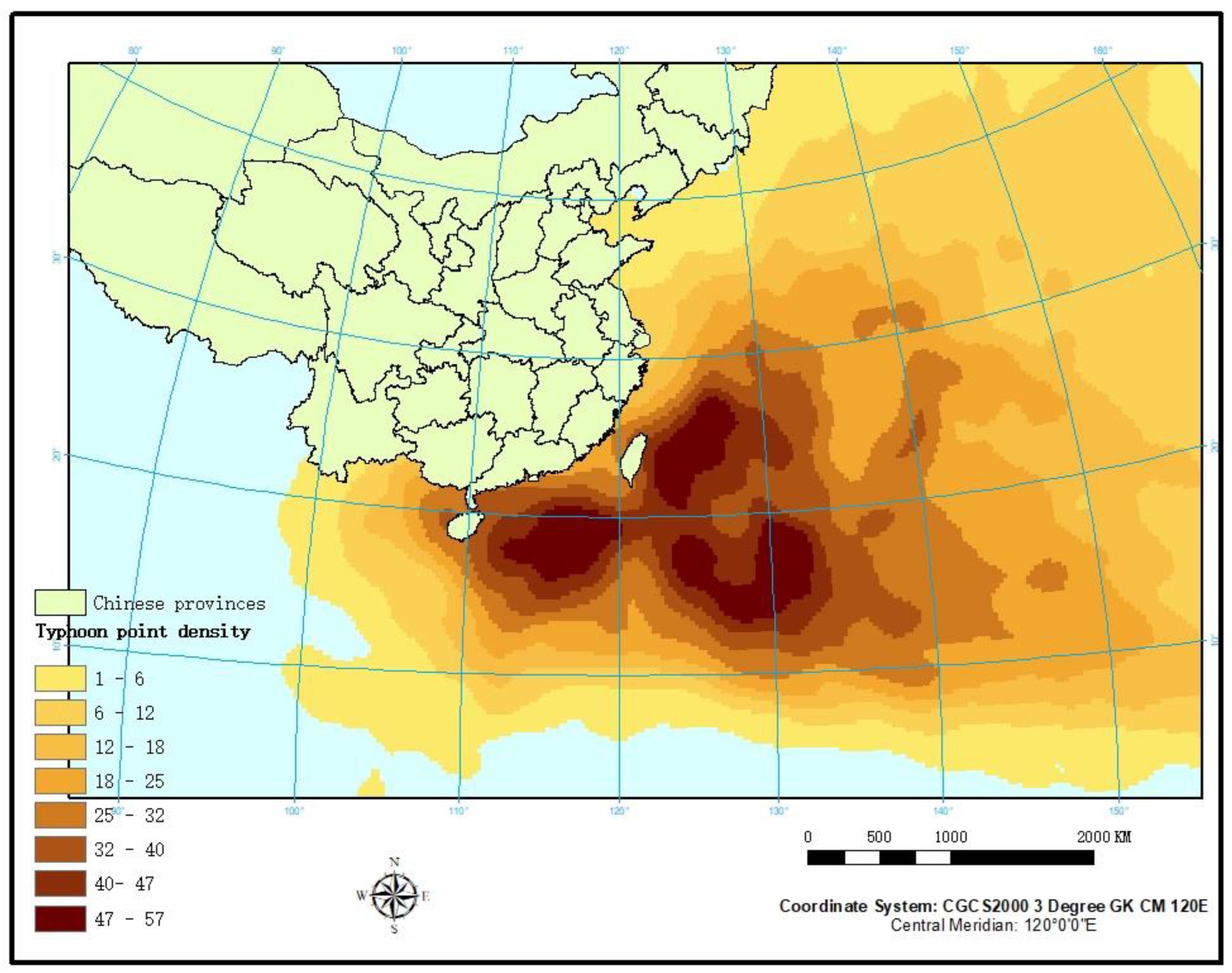


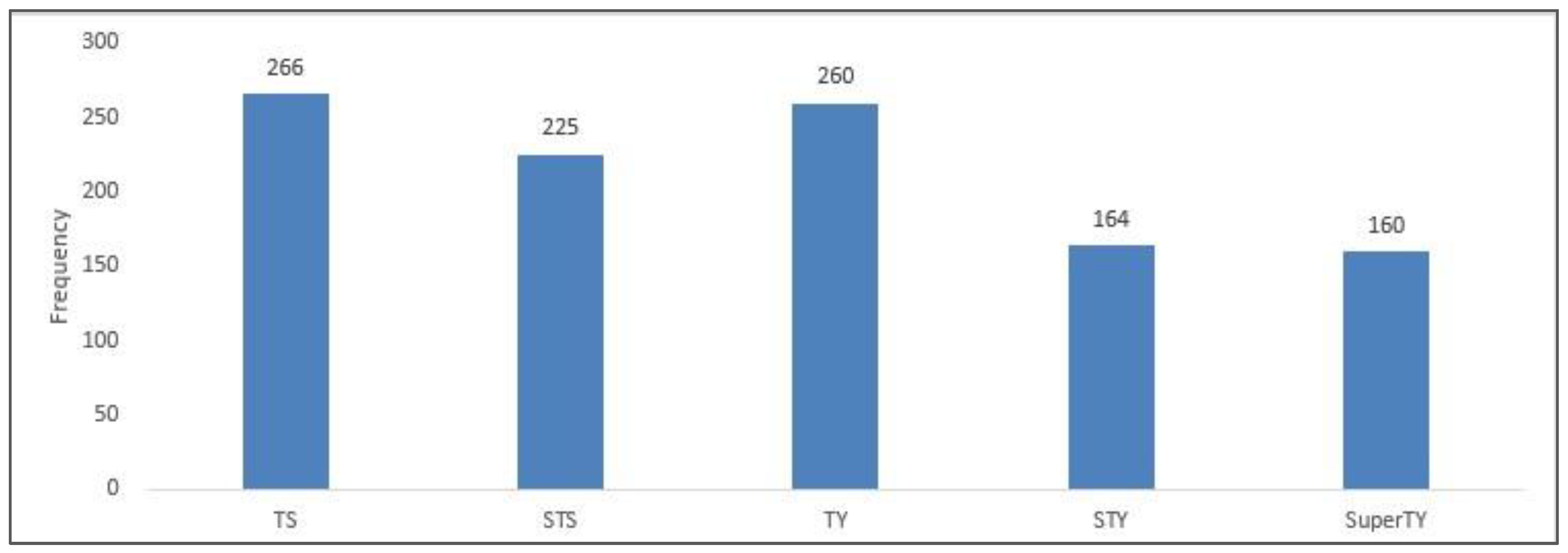
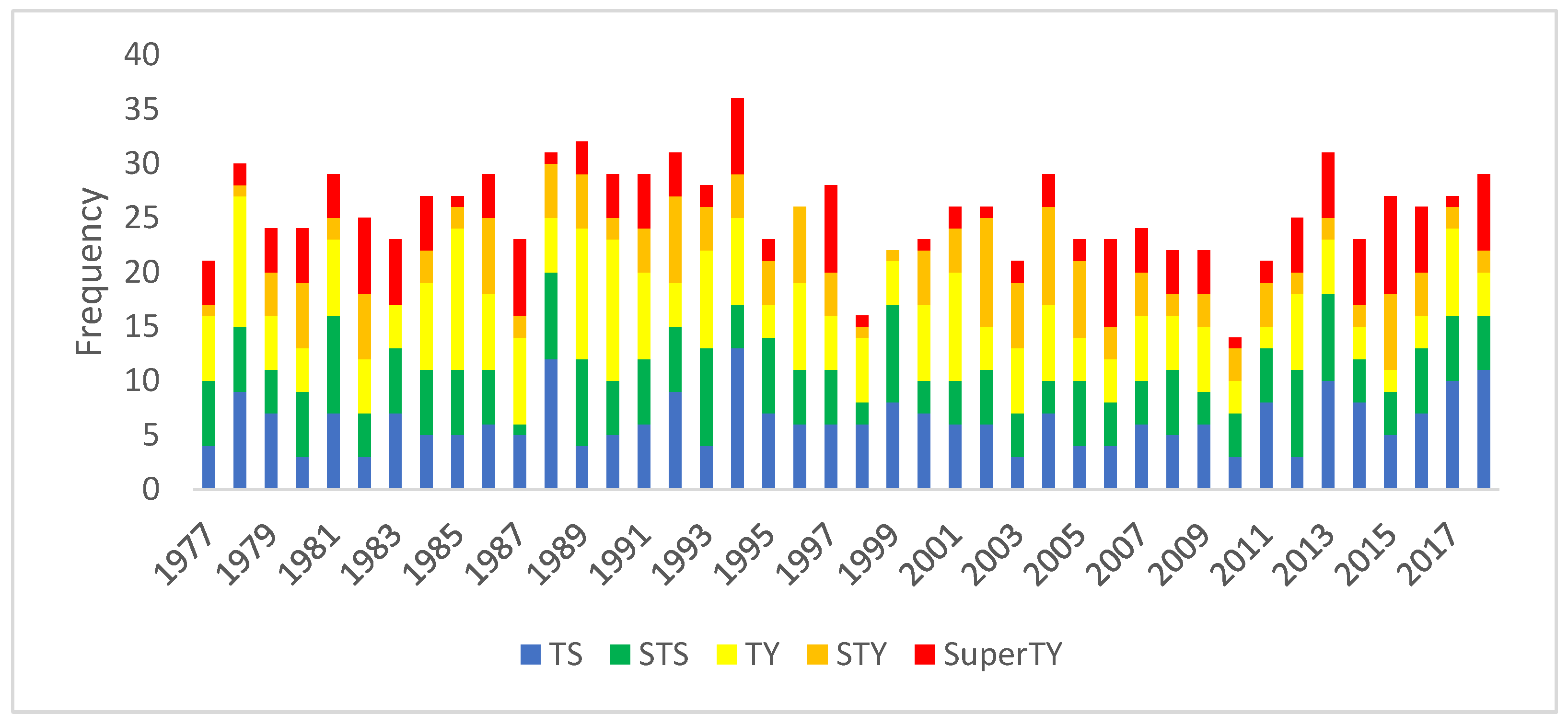

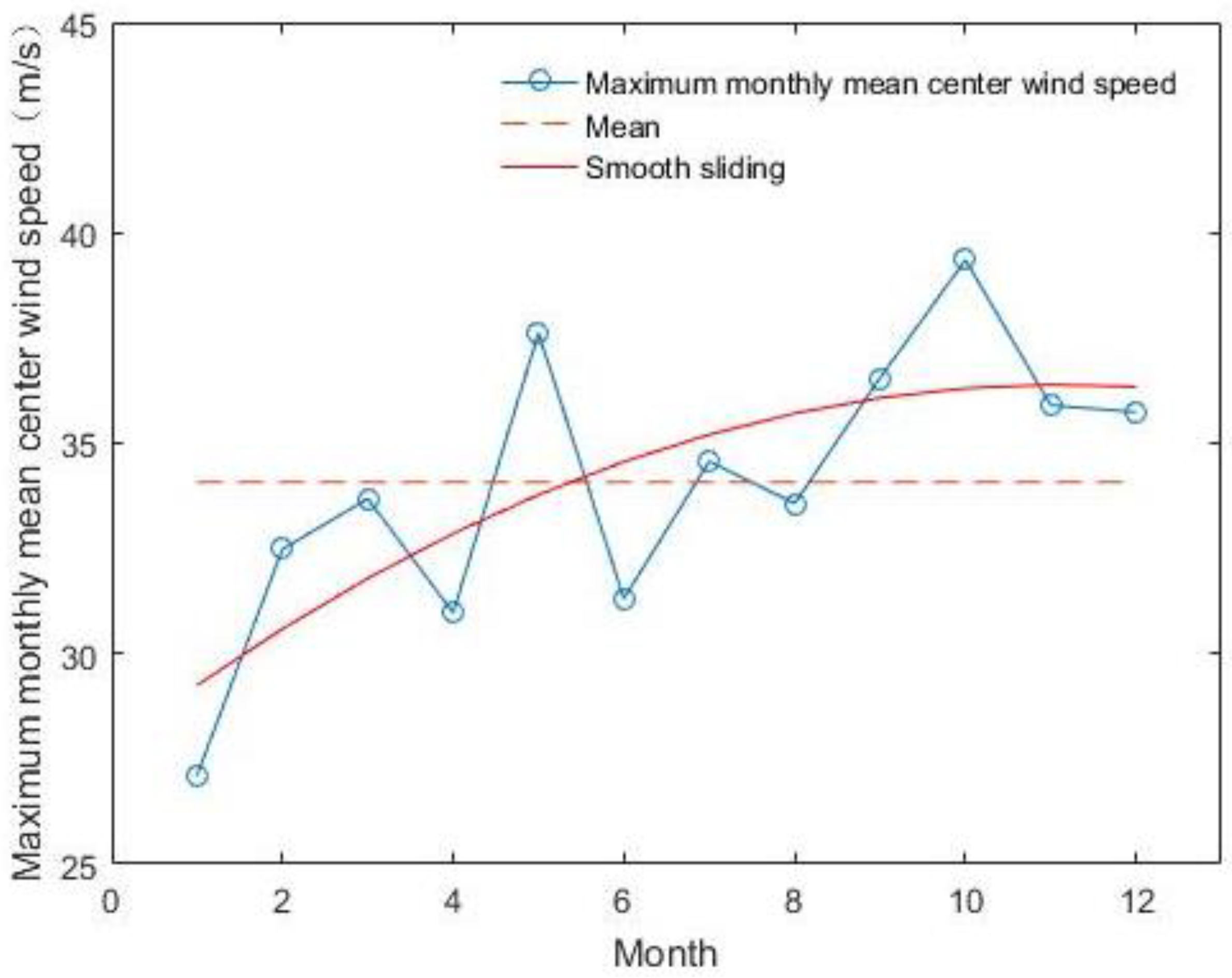

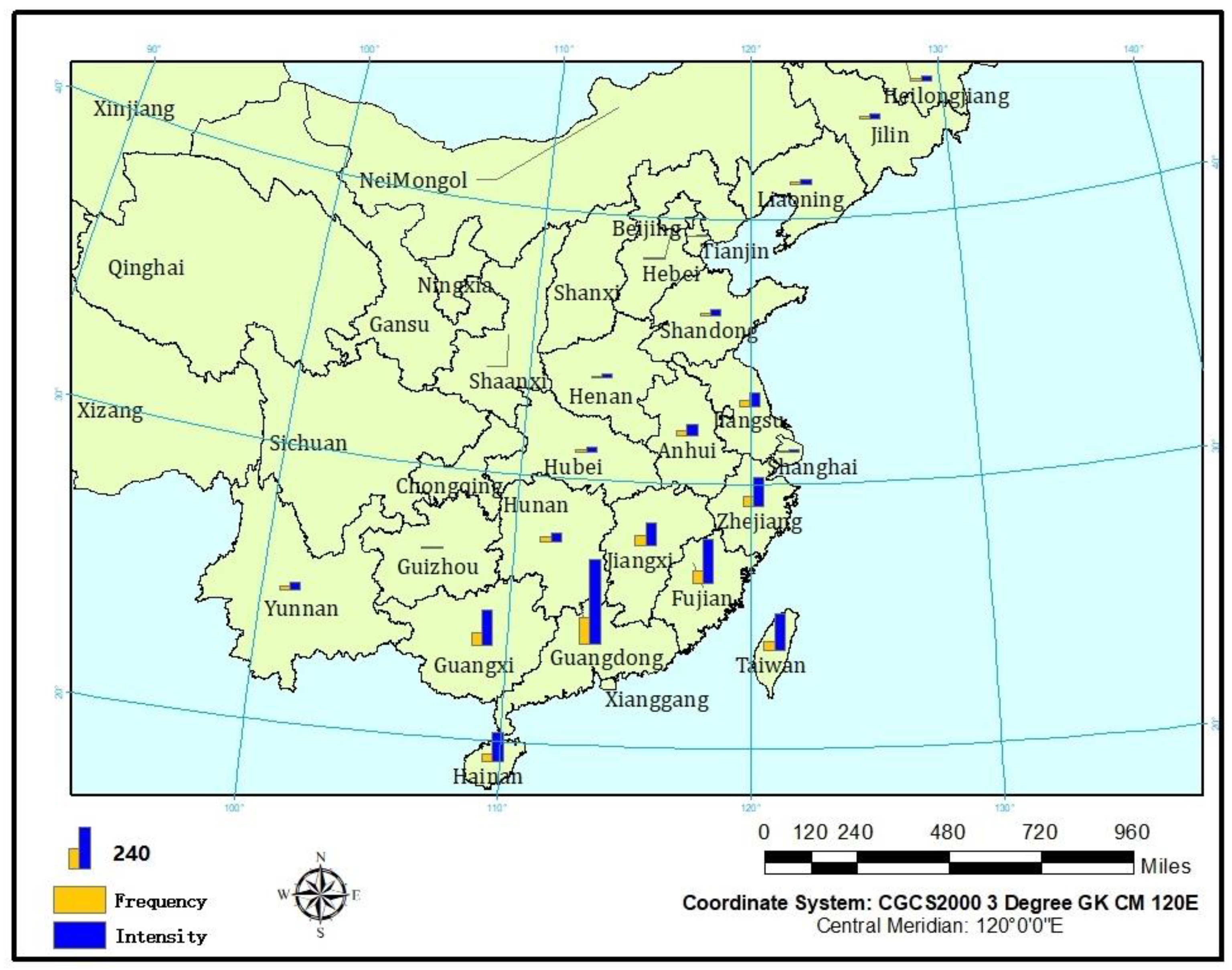
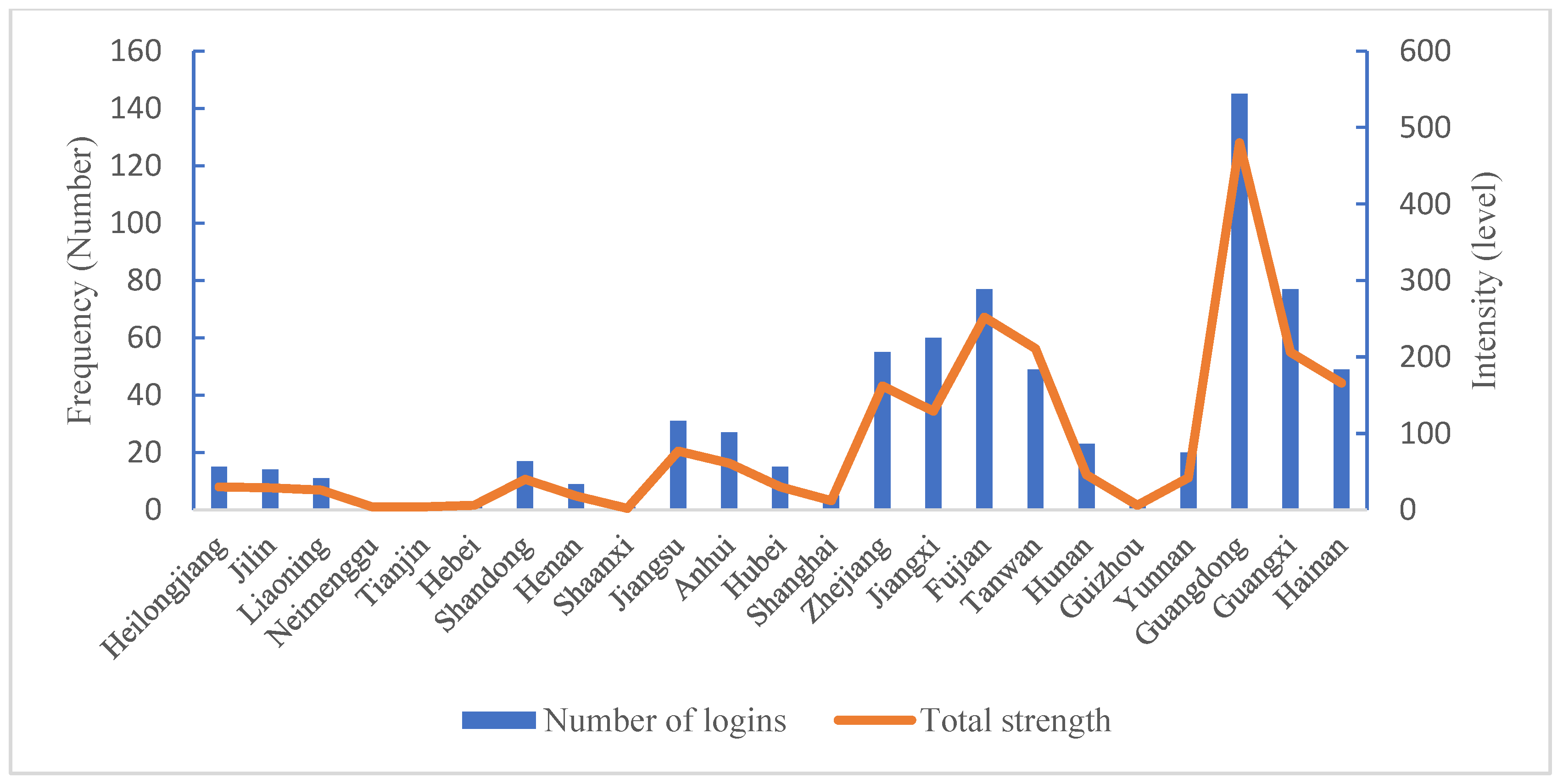

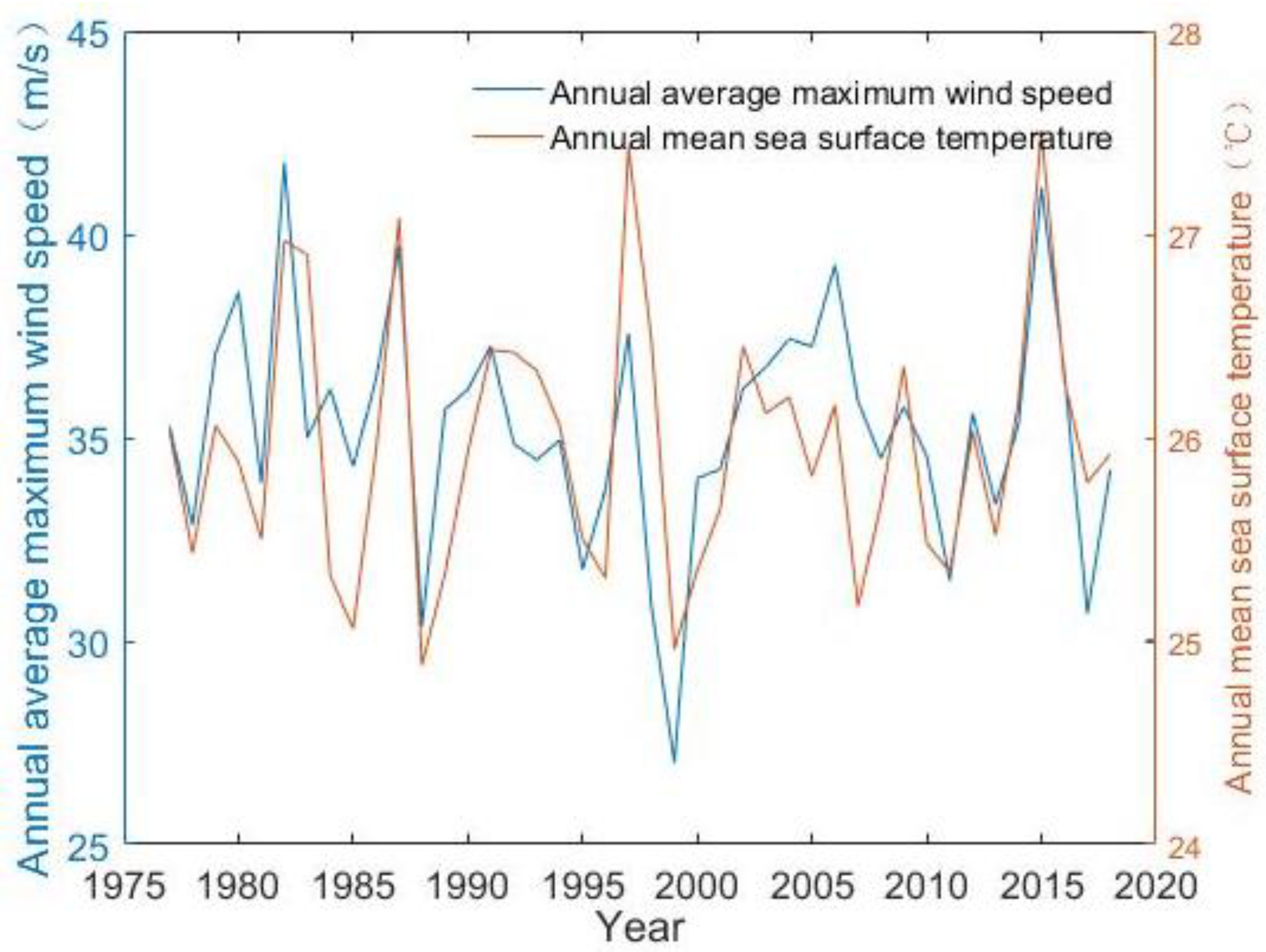



| Description | Interaction |
|---|---|
| q(X1 ∩ X2) < Min(q(X1),q(X2)) | Weaken, nonlinear |
| Min(q(X1),q(X2)) < q(X1 ∩ X2) < Max(q(X1),q(X2)) | Weaken, single factor nonlinear |
| q(X1 ∩ X2) > Max(q(X1),q(X2)) | Enhanced, double factors |
| q(X1 ∩ X2) = q(X1) + q(X2) | Independent |
| q(X1 ∩ X2) > q(X1) + q(X2) | Enhanced, nonlinear |
| Tropical Cyclone Rating | Maximum Average Wind Speed Near Bottom Centre (m/s) | Maximum Wind Near Bottom Centre (Level) |
|---|---|---|
| 1—Tropical depression (TD) | 10.8–17.1 | 6–7 |
| 2—Tropical storm (TS) | 17.2–24.4 | 8–9 |
| 3—Severe tropical storm (STS) | 24.5–32.6 | 10–11 |
| 4—Typhoon (TY) | 32.7–41.4 | 12–13 |
| 5—Strong typhoon (STY) | 41.5–50.9 | 14–15 |
| 6—Super typhoon (SuperTY) | ≥51.0 | ≥16 |
| Period | 1977–1979 | 1980–1989 | 1990–1999 | 2000–2009 | 2010–2018 |
|---|---|---|---|---|---|
| Average annual frequency | 7 | 7.5 | 7.8 | 6.8 | 8 |
| Number | Timing | Duration (Months) | Strength |
|---|---|---|---|
| 1 | 1982.05–1983.06 | 14 | Strong |
| 2 | 1986.09–1988.01 | 17 | Medium |
| 3 | 1991.06–1992.06 | 13 | Strong |
| 4 | 1994.01–1995.02 | 14 | Medium |
| 5 | 1997.05–1998.04 | 12 | Strong |
| 6 | 2002.06–2003.02 | 9 | Medium |
| 7 | 2004.08–2005.03 | 8 | Weak |
| 8 | 2009.08–2010.03 | 8 | Medium |
| 9 | 2014.11–2016.05 | 19 | Strong |
Disclaimer/Publisher’s Note: The statements, opinions and data contained in all publications are solely those of the individual author(s) and contributor(s) and not of MDPI and/or the editor(s). MDPI and/or the editor(s) disclaim responsibility for any injury to people or property resulting from any ideas, methods, instructions or products referred to in the content. |
© 2023 by the authors. Licensee MDPI, Basel, Switzerland. This article is an open access article distributed under the terms and conditions of the Creative Commons Attribution (CC BY) license (https://creativecommons.org/licenses/by/4.0/).
Share and Cite
Wang, J.; Zhu, S.; Liu, J.; Wang, X.; Wang, J.; Xu, J.; Yao, P.; Yang, Y. Frequency, Intensity and Influences of Tropical Cyclones in the Northwest Pacific and China, 1977–2018. Sustainability 2023, 15, 3933. https://doi.org/10.3390/su15053933
Wang J, Zhu S, Liu J, Wang X, Wang J, Xu J, Yao P, Yang Y. Frequency, Intensity and Influences of Tropical Cyclones in the Northwest Pacific and China, 1977–2018. Sustainability. 2023; 15(5):3933. https://doi.org/10.3390/su15053933
Chicago/Turabian StyleWang, Jie, Sirui Zhu, Jiaming Liu, Xun Wang, Jiarui Wang, Jiayuan Xu, Peiling Yao, and Yijie Yang. 2023. "Frequency, Intensity and Influences of Tropical Cyclones in the Northwest Pacific and China, 1977–2018" Sustainability 15, no. 5: 3933. https://doi.org/10.3390/su15053933




